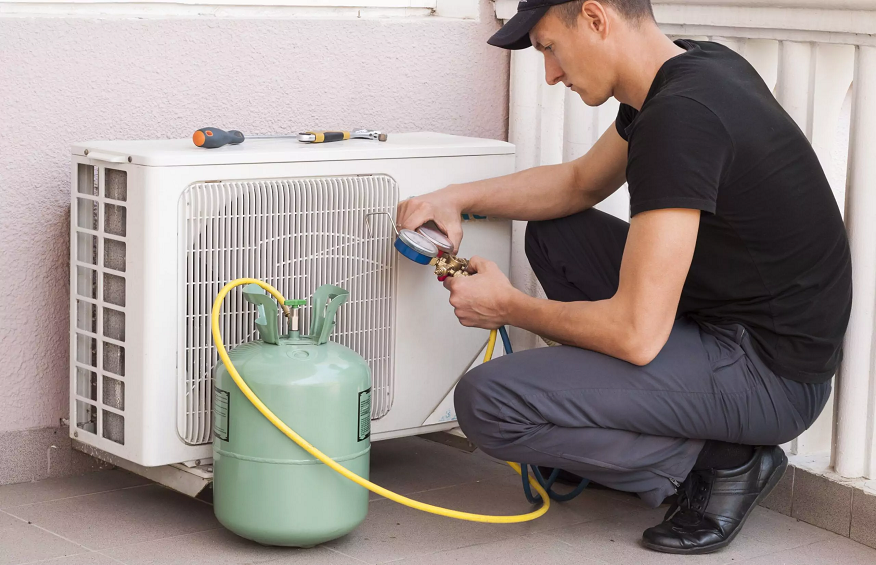A Step-by-Step Guide to Locating AC Refrigerant Leaks
5 min read
Regarding your home’s air conditioning system, there’s more to consider than staying cool. Understanding the potential threat of carbon monoxide poisoning is essential. Carbon monoxide, often referred to as CO, is an odorless and colorless gas that can be emitted by malfunctioning air conditioners. It poses a severe health risk, as inhaling it can lead to various symptoms, including headaches, dizziness, and even death in extreme cases. To ensure your safety, it’s crucial to have a basic understanding of how AC units can become sources of CO leaks.
The Initial Assessment
Essential Tools and Materials
To kickstart your journey in locating AC refrigerant leaks, you’ll first want to gather the necessary tools and materials. These include a UV dye kit, flashlight, safety goggles, gloves, a wrench set, and a pressure gauge. These tools will be your trusted companions throughout the leak detection process, ensuring you can effectively identify and address the issue.
Safety Precautions
Safety should always be a top priority when dealing with refrigerant leaks. Protect yourself by wearing safety goggles and gloves to shield against potential exposure. Additionally, ensure proper ventilation in the area to prevent any harmful fumes from lingering. Being mindful of the environment, consider using a leak detection kit that’s eco-friendly and safe for the planet. This way, you can tackle the problem while minimizing any negative impact.
Identifying Common Signs of Refrigerant Leaks
Before searching for leaks, it’s essential to know the common signs indicating a refrigerant issue. Watch for frost buildup on the evaporator coil, reduced cooling performance, or unusual hissing sounds from your AC unit. These red flags can point you in the right direction and help streamline your leak detection process, saving you time and hassle.
Step-by-Step Leak Detection
Visual Inspection: Examining Visible Components
When tracking down AC refrigerant leaks, starting with a visual inspection is paramount. Begin by examining your AC system’s visible components, such as refrigerant lines, connectors, and fittings. Look for any signs of oil residue, which can often indicate a leak. Watch for frost or ice buildup, which can also point to a potential issue. A meticulous visual inspection sets the stage for a more focused and effective leak detection process.
Using UV Dye: A Valuable Diagnostic Tool
UV dye is a valuable ally in your quest to pinpoint AC refrigerant leaks. Simply inject a small amount of UV dye into the system and let it circulate. Once the dye mixes with the refrigerant and escapes through a leak, it becomes visible under UV light. This method offers a clear and precise way to identify the exact location of the leak, making repairs quicker and more efficient.
Electronic Leak Detectors: How to Use Them Effectively
Electronic leak detectors are potent tools in the arsenal of AC repair professionals. To use them effectively, ensure your AC system is turned on and pressurized. Slowly move the detector’s sensor along the refrigerant lines and components, paying close attention to areas suspected of leaks. When the detector registers a refrigerant leak, it will emit an audible or visual signal, alerting you to the presence of a leak. Proper calibration and a systematic approach are critical to successfully utilizing electronic leak detectors.
Pressure Testing: Finding Hidden Leaks
When all else fails, pressure testing can uncover even the most elusive AC refrigerant leaks. Begin by sealing off the system and pressurizing it with nitrogen. Monitor the pressure over time; any significant drop indicates a leak. Use soapy water or a bubble solution on suspected areas to pinpoint the precise location. The escaping gas will create visible bubbles, revealing the leak’s location. Pressure testing is a thorough method for locating hidden leaks that might evade other detection techniques.
Repairing Refrigerant Leaks
Locating the Leak Source
Locating the source of an AC refrigerant leak is the crucial first step in resolving the issue. Start by performing a visual inspection of the refrigerant lines and connections. Look for any signs of oil stains or wet spots, which can indicate a leak. Next, trace the leak using a UV dye and light. Inject the dye into the AC system and then scan with the UV light to pinpoint the source accurately.
Sealing Small Leaks with Epoxy or Sealant
When dealing with small leaks, a cost-effective solution involves using epoxy or sealant specially designed for AC systems. Clean the affected area thoroughly, and once dry, apply the epoxy or sealant directly to the leak. Allow it to cure as per the manufacturer’s instructions. This approach effectively seals minor leaks, ensuring your AC system operates efficiently.
Replacing Damaged Components
Replacing damaged components is the way to go for more extensive or irreparable leaks. This typically involves replacing faulty valves, connectors, or tubing. Begin by depressurizing the AC system and carefully removing the damaged part. Ensure you have the correct replacement part ready, and follow the manufacturer’s guidelines for installation to ensure a proper and leak-free fit.
Recharging the AC System
After addressing the leak and making necessary repairs, recharging the AC system with the appropriate refrigerant is essential. This ensures the system operates at its optimal capacity. To do this, connect a manifold gauge set and follow the recommended refrigerant pressure levels specified in your vehicle’s manual. Don’t overcharge; it can hinder performance and potentially damage the system.
Preventative Maintenance
Regular AC System Inspections
Schedule annual AC inspections to catch issues like refrigerant leaks early, preventing costly repairs. Qualified technicians can identify problems, ensuring your system runs smoothly for years.
Tips for Extending AC Lifespan
Maximize your AC unit’s lifespan by changing filters regularly, maintaining airflow around the outdoor unit, and using a programmable thermostat for efficient usage.
Proper Refrigerant Handling
Ensure your AC technician follows eco-friendly refrigerant handling practices to protect the environment and comply with regulations, reducing ozone depletion and climate change impacts.
Safeguarding your home’s air conditioning system from refrigerant leaks is not just about comfort; it’s a matter of health and environmental responsibility. The potential risk of carbon monoxide emissions underscores the importance of staying vigilant. Armed with the right tools and knowledge, you can confidently identify and address leaks, protecting your family and preserving the planet. Regular inspections, proactive maintenance, and eco-friendly refrigerant handling are the cornerstones of a well-functioning AC system that delivers cooling comfort and peace of mind. By adhering to these practices, you extend your AC unit’s lifespan and contribute to a safer and more sustainable future.
Publisher’s Details:
ICE Heating & Cooling
2620 Regatta Dr Suite 102, Las Vegas, NV 89128
(866) 460-4372
iceaclv.com
[email protected]
When diagnosing AC refrigerant leaks, performing adequate maintenance regularly is crucial. For a comprehensive maintenance checklist, check out ICE Heating & Cooling’s blog post, “Effective Maintenance Checklist For Your Air Conditioning.” And they offer the best solutions if you need professional HVAC repair services in Henderson, NV.







